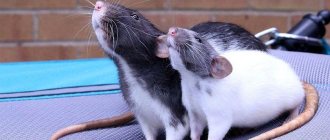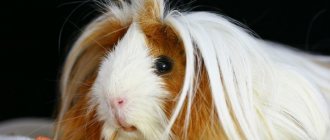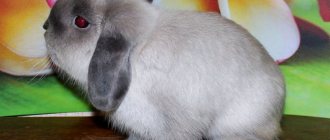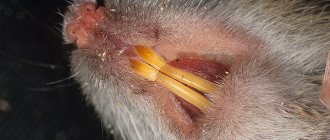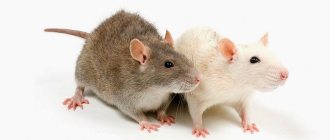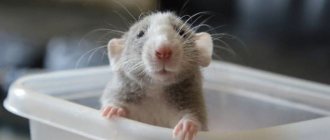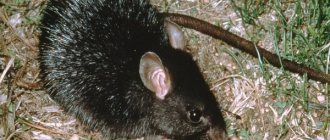- Wild animals
- >>
- Mammals
Contrary to popular stereotypes, a rat can be not only a minor pest and a carrier of especially dangerous diseases, but also a real pet, causing affection among all family members. Especially when it comes to ornamental animals! The Dumbo rat seems to be created to live with a person!
Description
The Dumbo rat has a distinctive feature - large round ears, which give it a special charm. But she is loved by rat breeders not only for her interesting appearance - the namesake of the Disney baby elephant has other advantages. However, Dumbo cannot be called an ideal pet either, so before buying a rat, you need to find out about the peculiarities of its maintenance.
Beginners in rat breeding, first of all, need to understand one thing: all the names of decorative rats (Dumbo, Rex, Sphinx, etc.) indicate variations of the same breed - Rattus Norwegicus dom (decorative rat). One litter can contain pups of different variations.
Belonging to a particular variety is determined by the structure of the animal’s body, the characteristics of its appearance and the quality of its fur. Dumbo rats can have characteristics of other breeds and are called Dumbo Rex, Dumbo Sphinx or Dumbo Husky.
Dumbo has a pear-shaped body, the maximum size of which reaches 20 cm in length, with short, dense fur. The ears of these rats are located lower than those of their relatives.
Habitat and characteristics of the breed
Rodents of this breed are not found in the wild; they are bred specifically for decorative purposes. The name of the animal was given by a Disney elephant calf, which differs from other representatives of its species by its large ears.
The characteristic features of the Dumbo rat are:
- Large, compared to the size of the rest of the body, low-set, rounded ears
- Pear-shaped short body
- Pointed muzzle
- A long tail
The size of the dumbo rat is practically no different from the size of its relatives; weight – up to 400 grams, length – up to 20 cm. Of course, there are larger individuals, but they are quite rare.
- The larger the ears of a rodent, the more valuable a representative of the breed it is.
- The homeland of dumbos is California, and they were brought to Russia in the early 2000s. from England.
- The gene responsible for the shape of rodent ears is recessive. This means that rats with large round ears can give birth to quite normal offspring. And he, in turn, has little rats that meet most Dumbo standards.
Differences from wild rats
While ornamental rats are very similar to their wild relatives, there are significant differences between them. The most noticeable difference is the appearance. Random mutations (mostly in color) can occur in the wild, but are rare.
Decorative rats are calmer and less aggressive towards humans due to breeding and, as a result, the constant selection of producers with the desired set of behavioral qualities. However, ornamental rats, like any other domestic animals, can become wild and over several generations produced in natural conditions, their behavior and attitude towards humans can become indistinguishable from initially wild rats. This phenomenon is regularly encountered by rat lovers who are engaged in catching colonies or families of decorative rats that find themselves on the street.
Decorative rats have greater body weight and fertility. They are less afraid of new products, they have a calmer reaction to light and sound, and neophobia is less developed. Wild rats are mainly nocturnal, sometimes going out during the day in search of food. In domesticated rats this is not so pronounced. In a fight, wild rats produce sharper screams than domestic ones. In addition, a wild rat that loses a “battle” almost always runs away from the winning one, while domesticated rats can behave differently after a fight.
Domesticated rats live longer than wild ones. This is because kitty rats are protected from predators and always have access to food, water, shelter and veterinary care. Their average lifespan is approximately 2–3 years, unlike wild ones, which on average live less than 1 year. Wild rats have larger brains, hearts, livers, kidneys and adrenal glands. However, decorative rats, like wild ones, are susceptible to many different diseases, among which a special place is occupied by the respiratory syndrome of mouse-like rodents (respiratory diseases of various etiologies), as well as various neoplasms (tumors of the mammary glands, brain, etc.).
Colors
The color of animals of this breed variety, as well as the length and quality of the coat within the species, can vary greatly. Most often there are individuals with short, velvety, straight hair in gray, white, black and chocolate colors. Rare colors of dumbo rats are Siamese, amber, topaz, and mosaic (tricolor).
Amazingly beautiful Dumbo rat of blue mink color. You can find it only from large breeders at a price that is quite high for decorative rats.
Scientists, by crossing rodents of the Dambo breed variety with decorative rats of other breeds, managed to obtain new subspecies that deserve the attention of amateur rat breeders.
Dumbo rats have the following subspecies:
- German Shepherd
- What kind of snakes are kept at home?
- Ancient dog breeds
- Dog's sense of smell
- Maine Coon
- Domestic iguana
- Sphynx - can be white, blue, chocolate and black. Their body is completely devoid of vegetation. There is some hair on the back, paws and head. There are either no mustaches at all, or they are very small and curled upward. Suitable for people with allergies;
- rex - on the contrary, has thick, wavy and fairly stiff hair;
- Husky is a chameleon rat. Only it has the amazing ability to “bloom” - to change color with age. Babies are born of a standard color - black, gray, red, etc., but with age, their fur is diluted with white hairs - so that, born black, a rat pup, having matured, turns into a snow-white miracle. Their ideal color is “salt and pepper.”
Rats are very similar to people - they can dive and swim, are subject to stress and psychological shocks, dream, are afraid of tickling and can laugh, albeit in the ultrasonic range.
Experienced rat breeders know how long domestic Dumbo rats live. And you won’t be able to please beginners with the length of your pet’s life – you need to immediately get used to the idea that your pet will stay with you for about 2-4 years. Thanks to good care and nutrition, many manage to extend their life by a year and a half, but no more.
Varieties
Thanks to breeding work, several varieties of domestic dumbo rats have been developed. They differ in color and coat type.
Dumbo Rex rats have thick, curly fur. The cover is soft and silky. Little rats' fur does not curl, but sticks out in different directions, it looks very funny. In adult pets, formed curls can be seen. Mustaches can also curl.
Siamese
This is a very beautiful and rare variety with an original color, like a Siamese cat. The main shade of six is cream. There is a dark mask on the face and paws.
The gene that is responsible for this type of color is recessive, so it is passed on only to some cubs from the litter. This explains the high cost of Siamese rat pups.
Husky
Dumbo Husky rats are very popular. Pets with this color have dark fur of gray, brown or almost black color. As the animal grows, snow-white hairs appear, which are concentrated in the muzzle area, on the neck and abdomen.
Blue
Decorative blue Dumbo rats are very beautiful, so breeders often sell them at a higher price. These pets have light gray fur with a distinct bluish tint.
Manx
Domestic Dumbo Manx rats are the result of complex genetic mutations. This variety differs from others not in the type of coat or color, but in the absence of a tail.
Although the animal looks funny, life is hard for him without a tail. This part of the body is necessary to maintain balance. It also plays an important role in thermoregulation - the tailless rat often suffers from overheating. Therefore, for reasons of humanity, veterinarians are against breeding Manx cats.
Sphinx
These are unique representatives of the species that differ from their relatives in the absence of hair. The hairless Dumbo rat has numerous folds on its skin, like cats of the same breed. The vibrissae are underdeveloped and curled, but the standard allows for their absence.
Dumbo Sphinx rats require special housing conditions, as they are susceptible to colds and often suffer from skin damage.
Description of character
Rats are intellectuals with a soul and are very attached to their owner. They need communication and attention, otherwise they will wither away. The character of domestic rats of the Dumbo breed is calmer and more reserved than the rest. They are not that active. Very sociable, freedom-loving and cheerful. Experts advise taking rat pups not from pet stores, but from breeders, when they are very young, then the pets grow up to be affectionate and trusting little animals. Dambiks are very clean. If their house is dirty, they take care of cleaning themselves.
Pros and Cons of Keeping Dumbo as a Pet
The decorative rat is one of those pets that does not require large expenses for its maintenance. Rats are curious and everyone wants to try their teeth. In addition, they require constant attention as they can fall and get hurt.
What attracts these animals is their developed intellectual abilities and lack of aggression towards humans and other animals.
The advantages of choosing Dumbo the rat as a pet include:
- cleanliness of the animal;
- omnivorous;
- low maintenance costs;
- ease of care.
But there are also disadvantages:
- the property of an animal to leave marks wherever it is;
- tendency to chew on any objects;
- expensive treatment;
- people with a keen sense of smell notice a specific smell that comes from domestic rats;
- for your pet to feel well, you need to devote a lot of time to it;
- walking is required;
- relatively short lifespan.
Games and training
Once tamed, rats become obedient and therefore easy to train. Animals love to play with balls, climb tunnels and climb up a person’s body onto a person’s shoulders. To train rodents, you must adhere to the following principles:
- Do not continue classes for more than half an hour.
- Feeding should be done 8-10 hours before training. An empty stomach will help your pet learn the trick faster.
- The rodent must fully master the previous skill before moving on to the next activity.
Dumbo can be taught to find one item from a bunch of others, get hidden objects and treats, and stand on his hind legs.
Care and maintenance
This type of rodent was bred artificially, so it can only exist next to humans. And, naturally, it requires attention and knowledge on how to care for the rat Dumbo. The baby needs to immediately create suitable living conditions. The room where the little tenant will live should be bright and sunny. A cage for a decorative rodent should be placed at a height of 1-1.5 m from the floor, away from windows, radiators, stoves, and strong noise.
It should be made of metal rods (so as not to be chewed through like plastic ones) and with a deep tray. Size – quite large (minimum 40 x 30 x 50 cm). It is not recommended to use an aquarium for these purposes - it will be difficult to restore order there, plus there is no necessary ventilation. A mandatory accessory of the cage is the “house”. The pet will rest there. And all kinds of stairs and tunnels intended for entertainment are desirable, but not required. A ball drinker (not a bowl) and a fixed feeder are also necessary.
It is better to use corn, pressed sawdust (not very large in size), and paper as filler. Do not use cat litter, newspapers, or pine sawdust. You need to do “general cleaning” in the cage once a week, or more often. And the water needs to be changed every day. The temperature in the room where everyone's favorite lives should not exceed 30 degrees, but also not fall below 20 °C.
A cage for a decorative rat should not be in a draft or in direct sunlight - this has a detrimental effect on rodents.
Where does the Dumbo rat live?
Photo: Dumbo domestic rat
The wild predecessor of the cute “dambiks” inhabits mainly Asian and South American jungles, like all other breeds of rats, occupying almost all available niches. But the tame rat Dumbo, to which this article is dedicated, is much more demanding regarding the conditions of its maintenance. But all the costs and efforts of the owner are paid off a hundredfold by the boundless trust and tender affection expressed to him by the furry animal.
Regarding ensuring proper conditions of detention, there are several options, each with its own advantages and disadvantages. It is best to use an ordinary cage as a home for Dumbo rats - believe me, there will be plenty of living space in it. You can buy a dambiku wire cage at a pet store. The optimal dimensions are 60x40x60 cm with a maximum distance between the bars of 1-1.2 cm. A cage for a dumbo rat must have a solid bottom, a high tray (only made of plastic, wood and metal are not suitable), as well as wide doors and shelves.
To eliminate the specific rat odor, it makes sense to purchase corn or wood filler. Some owners use napkins, toilet paper and sawdust instead. If you can still agree with the last option, then the first two are completely unsuitable. The furry rodent's cage is equipped with hanging metal bowls intended for dry food. In addition, you cannot do without a special nipple drinker. Various treats and liquid food are best placed in small ceramic bowls.
To ensure maximum comfort for a little rat, it makes sense to place a house inside the cage. Dambiks love to hide and sleep in it. A cozy, warm hammock will be a favorite accessory for decorative rats - but this is where the adults will spend their “leisure.” Stairs, tunnels and ropes will also be used by rats for their runs.
Feeding
These pets are quite unpretentious in their choice of food, but are not omnivorous, like ordinary ones. Decorative rats are very gentle creatures, often having problems with the intestines and allergies.
Its menu should include:
- grain base - it is better to purchase a special mixture for rodents in pet stores. It should make up 60% of the total diet. You can also feed with unprocessed pumpkin, flax or sunflower seeds;
- proteins - occasionally (1-2 times a week) give a little meat (raw or boiled), chicken, yogurt, cottage cheese, eggs will benefit your pet;
- herbs - parsley, cilantro, dandelion, dill, plantain, radish tops;
- vegetables and fruits (preferably boiled) - apples, bananas, carrots, white cabbage, cucumbers, tomatoes, pumpkin, eggplant, potatoes. Citrus fruits must be treated selectively - they can cause allergies in your pet;
- delicacies - grain sticks, nuts, dates, berries, dried fruits, raisins, crackers (unsalted only), unsweetened cookies, boiled pasta, boiled shrimp and seafood.
It is necessary to give fish oil and specialized vitamins. Animals are fed 2 times a day: morning and evening. The exception is pregnant rats - they are fed 4-5 times a day. If you adhere to the basic requirements for what to feed your rat Dumbo, he will be healthy and cheerful.
If your pet refuses to eat for 1-2 days, you should immediately show him to a veterinarian!
Prohibited Products
If the owner is interested in his pet living as long and healthy as possible, the following products should be avoided:
- chocolate and products containing it;
- other sweets;
- sausage and frankfurters;
- canned food for people;
- raw beans and other legumes;
- cheeses (especially blue and salted);
- soda;
- sprouted potatoes;
- Brussels sprouts and red cabbage;
- green bananas;
- spinach;
- beet;
- fatty and salty foods.
Knowledge of what can and cannot be given to decorative rats will help you correctly formulate the rodent’s menu and avoid unnecessary worries and health problems.
Nutrition
The rat diet should be based on ready-made food. Mandatory feed additives include cereals and vitamins. You can feed your pet with the following:
- half-boiled porridge;
- fruits (especially apples and plums);
- greens;
- boiled lean chicken;
- boiled eggs;
- fruits;
- seeds;
- sour cream;
- kefir
Unsweetened crackers can be given as a treat.
Bathing rats
Perhaps, rats can be divided into two “camps” - some are wary of bathing, and you will have serious problems when trying to bathe your pet, while others will happily climb up to perform bathing procedures.
Rats are very clean and you shouldn’t have a need for a “routine” bathing as such, and you shouldn’t bathe rats unnecessarily .
However, there are times when bathing is necessary:
- The rat got very dirty with something that it absolutely cannot eat (while walking around the house, rats can accidentally knock over something).
- The rat emits an unpleasant odor and has an unkempt fur or tail (if you have not had the opportunity to change the cage substrate for a long time, for example, or if the rat does not take care of itself);
- If you need to detect and remove parasites;
- Older rats need to be bathed as they find it difficult to groom themselves.
Appearance of a rex rat
Rex rats were bred on the basis of the Standard breed, their main parameters coincide with this designation, with the exception of the composition and quality of the fur.
The body length of the imago sometimes reaches 27 cm.
Important: The main difference between a Rex and a standard rat is that there is less hair in the coat structure.
Curly rats have a dense coat with evenly distributed curls. They have almost no fluff on their bellies. The fur has a low hair content, so their coat is not as shiny as a standard rat's.
The vibrissae are strongly curled, but have a shorter length compared to the vibrissae of other ornamental rodents. The curly fur of a rat is a little thicker, but not very coarse.
Wavy rexes have fewer curls than curly rexes, but their fur is dense and soft, and appears slightly ruffled from the side. Their dense undercoat has a uniform hairline. They can be slightly longer than curly rats and have a wavy shape. Sometimes there are people with vibrissae that curl at the ends.
These animals are especially charming due to their thin tentacles, which are located just above the eyes.
A purebred rex rat has the following characteristics:
- Thick and curly coat with bouncy curls;
- wide, slightly blunt muzzle;
- large, widely spaced ears;
- The bushy tail is also a characteristic of the breed.
Rat fur has a plush softness. Children are born curly if both parents have the curly hair gene. Rex puppies always have a somewhat disheveled appearance - over time, their undercoat begins to fall out and hairless spots form, but these are quickly replaced by new hair.
Interesting! There are mongrels of this breed. Red and black or red and ruby color combinations are not considered a defect. They can occur in animals with any marking.
How to bathe a pet rat?
There are some rules that you need to know in order to buy a rat correctly, but each owner will figure out the nuances himself. During the first baths, it would be useful to have a second person present as additional insurance in case the animal gets scared.
- The room must be securely fenced off from drafts - rats catch colds quite easily.
- The water should be warm, but not hot.
- It is necessary to bathe the rat in a container with a small amount of water, especially if it is afraid to bathe. Ideally, the rat can stand in the water.
To wash, use a special shampoo for rats - this will not cause an allergic reaction and will make your pet’s fur smooth and shiny, and the special shampoo is easier to wash off.
Be sure to read the instructions - some shampoos require first diluting with water.
Be careful not to get the shampoo in the rat's eyes. Also, during bathing, it is necessary to ensure that water does not get into the animal’s ears; this is fraught with complications, including deafness.
Rats' skin is very delicate; for heavily soiled areas, you can use a very soft sponge, but it is preferable to use your hands. Massage the rat's fur as carefully as possible so as not to touch it with your nails.
After bathing, carefully dry the rat with a towel and then leave it to dry, preferably wrapped in another dry towel.
If you have several pets, the first time after returning from swimming, carefully monitor their behavior - when bathing rats, their natural smell is “washed away”, and relatives may not recognize their companion at first.
Remember that bathing rats is unacceptable if they have wounds or scratches on their bodies, or if the rat is sneezing or showing other signs of illness.
If only the tail or paws, for example, or a small area of fur are dirty, you can get by with “local” cleaning instead of a full bath.
What living conditions are required for decorative rats?
It is best to place the rat in a spacious wire cage Caring for your rat. Height - no less than 50 cm, minimum floor area - 50 × 80 cm. The flooring must be hard and even, for example plastic. The option with rods will not work: the animal may damage its paws.
Photo: borisenkoket/Shutterstock
There are several rules for placing a house. Rodents are susceptible to cold and heat. They feel best at a temperature of 20 degrees. Therefore, the cage is usually placed away from direct sunlight, radiators and drafts. If there are other animals in the house, then the home should be, for example, on the Rat: Species Profile nightstand or table.
A nipple drinker and bowls must be placed inside the cage. If desired, you can buy a tray and filler for rodents. The rat should also have a shelter: a hammock or a house.
Photo: Bilanol/Shutterstock
Rodents love toys very much. For entertainment, owners choose running wheels, tunnels, platforms and wooden figures. The latter should be changed regularly, otherwise the animal will get bored.
Rats like to make nests. Therefore, you can periodically put paper in the cage. Remember that newspaper sheets will not work. The ink can cause poisoning to your pet.
Diseases and treatment
It’s hard not to notice if your pet is unwell. A healthy rat has shiny fur, clear and clean eyes, and the animal is playful and active. If deviations in health status are observed, you should immediately contact a veterinarian.
The most common diseases of decorative rats:
- Mycoplasmosis . Infection occurs through airborne droplets and progresses to pneumonia. Deadly dangerous.
- Abscesses . Associated with injury to the animal. An opening and disinfection of the inflammation site is required.
- Development of benign and malignant tumors.
- Parasitic lesions. Rats are not dewormed. Treatment is carried out only if the disease is detected.
Vaccination
Decorative rats do not need vaccination. No drugs have been developed for them to help prevent the development of diseases in these animals.
Selection and accessories for your pet
An animal's cell must contain several elements:
- drinking bowl;
- feeder;
- nest (place to sleep);
- a mineral stone on which the animal will grind its teeth.
To prevent the animal from getting bored, toys are placed in the house. Rats are very fond of such a device as a hammock. It can be made from a piece of durable fabric or purchased ready-made at a pet store.
Most preferred toys:
- ladders, including rope ones;
- tunnels;
- labyrinths.
Types of decorative rats
There are several varieties of the Dumbo breed:
Siamese
The color of the Siamese is similar to that of the cat breed of the same name: white or light beige fur and a small brown spot on the face.
The color of the husky is similar to the color of the coat of the dog breed of the same name: white coat with dark spots on the body and head.
The Rex's long curly coat, hairs and whiskers are slightly curled.
Sphinx
There is no wool. The skin is thin, soft and warm. The main advantage of the species is its inability to cause allergies.
A cage with metal bars is needed so that the animal cannot chew them. It must be installed in a place that is not in a draft, in direct sun, near a radiator or heater. The cage size for 1-2 rats is at least 60x40x30 cm.
The room temperature should not fall below +20 degrees, otherwise there is a high probability of your pet catching a cold.
The cage contains attributes for entertainment and sleep: a house, a wheel, pipes, ladders.
Large sawdust or dry granules are suitable as filler.
You cannot put newspaper paper in a cage.
When wet, it emits toxic substances contained in printing ink, which causes great damage to the health of the animal.
The filler is changed every 2-3 days. Once every 15-17 days, all elements of the house are treated with a disinfectant.
Dry air can harm your pet's health, so the humidity in the room should be 50-55%.
Dumbos are friendly and easy to get along with if treated affectionately. It is forbidden to talk loudly near the animal, shout at it, hit it, push it hard, sharply grab it or pick it up.
When the cage is heavily soiled, Dumbo rats can squeak loudly; when there is a lack of food, they can rattle the feeder or stand on their hind legs next to it.
To grind down teeth, rats are provided with wooden sticks made from hardwood.
Dumbos are distinguished by their friendliness and easy-going nature, so they easily get along with other animals. The main problem becomes the character of the rat's neighbor.
These animals do not like to sit in a cage all the time, so they need to be walked around the house. The owner needs to be careful: there is a risk of not noticing the pet and stepping on it. In addition, your pet may chew on wires.
Bathing is often prohibited, only in cases of extreme necessity. These animals are susceptible to colds. In case of local contamination, you can remove the dirt with a damp cloth.
Reproduction
How to determine gender?
Males can be distinguished from females by their enlarged testicles, which are clearly visible already at the age of 2–3 weeks. In female decorative rats, the rudiments of nipples are observed during this period of life.
Mating
Sexual maturity occurs early - at the age of 5–6 weeks. But individuals from 8 to 10 weeks are recommended for mating. In order to get offspring, it is enough to leave the male and female in the same cage for a couple of days. But you need to understand that fertilization is possible only if the female is in heat. It occurs regularly at intervals of 4–7 days.
Pregnancy
From the moment of fertilization to the birth of rat pups, no more than 23 days pass. On average, birth occurs between 21 and 23 days. The female's pregnancy becomes noticeable starting from the second week after fertilization. The animal’s physique plays a big role in the appearance of the first signs. If the female is thin, the rounded tummy will be noticeable faster than in a fat and large rat.
A litter can contain from 8 to 15 pups. During pregnancy, the female needs increased and nutritious nutrition. Bloody discharge and the female's desire for privacy will indicate the approaching birth . Often the dumbo rat begins to prepare its nest: it cleans and arranges it. Childbirth lasts no more than 3 hours.
How to care for newborn rat pups
The female Dumbo takes good care of her offspring.
During this period, the owner must follow several rules:
- do not pick up baby rats;
- take care of the cleanliness of the cell;
- provide the mother with good nutrition.
Rats can be handled once they are 14–15 days old.
Features of home maintenance
The rat needs a big house where it can run freely without limiting its play time. Due to the high sociability of this species, it is recommended to have several individuals at the same time.
If only one curled up rat can be kept, its cage should contain:
- Swing;
- house;
- climb;
- various entertainments.
Animals are omnivores, but for good health it is necessary to supplement the diet: ready-made industrial feed, vitamins and cereals.
The Rhesus rat's cage should be equipped with entertainment devices.
These animals are easy to care for: just change the food regularly and clean the cage daily. Twice a month their “apartment” must be disinfected. Experts recommend feeding in uneven portions, leaving a large portion for the evening.
Clean water should be available at all times, and then the playful pet will entertain the owner with fun games every day.
Choosing a name for Dumbo the rat?
The owners are trying to give the young, smart baby Dumbo a deep and meaningful nickname in the hope that the animal's name can influence the character and intelligence of the funny animal. Sometimes it can be difficult to immediately name a pet with a suitable name that emphasizes its individuality and expresses the love of its owner.
It is advisable to take a few days to take a closer look at the habits and character traits of the new family member; most likely, he himself will tell the owner what to call him. The furry baby's nickname can be tied to the color of the rodent's coat and funny ears, human associations from the pet's appearance and funny faces, favorite book and cartoon characters or pop stars. The rodent's nickname should be simple and easy to pronounce in a diminutive form. It is believed that females respond better to nicknames that begin with the letters K, M and D. Males are more fond of names with the letters S, K, M and D, long-eared pets are more willing to get used to nicknames with the letters T, N, L, M, K , S, Sh and R.
The name for a Dumbo rat girl can be: Knopa, Scully, Masya, Dana, Molly, Ksyusha, Marta, Alice, Dasha, Klava, Matilda, Gina, Darcy, Alpha, Kayla, Linda.
The name for a dumbo boy rat can be: Kuzya, Tyson, Tim, Rocky, Simson, Garik, Steve, Venya, Bucks, Rocky, Dick.
It doesn’t matter what the owner calls the smart-eared baby. In any case, the baby rat Dumbo will sincerely adore and faithfully wait for his beloved owner, giving him his incredible tenderness and selfless love.
Video
What do you call a Dumbo rat?
To choose a name for your pet, you should adhere to the following rules:
- You don't need to give Dumbo the first thing that comes to mind. At first, you need to observe the animal and note its characteristic features.
- The name must be special and important to the owner.
- You can name multiple pets from the same category.
- Cartoons, TV series or children's fairy tales will help you suggest a suitable nickname.
Rats adapt more easily to names starting with D, M or K. For males, nicknames containing the letters S, D, M, K are suitable, while for females - R, L, K, M, N, S, T, Sh.
Suitable names for female rats:
- Alice;
- Klava;
- Matilda;
- Molly;
- Button;
- Gina.
Male rats can be called:
- Tyson;
- Rocky;
- Splinter;
- Harry;
- Steve;
- Tim;
- Zaks.

